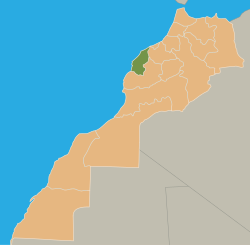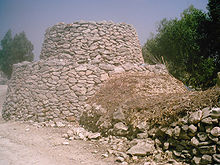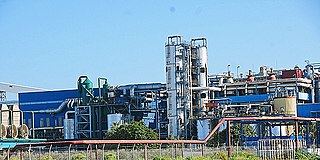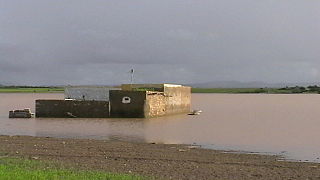Doukkala
Doukkala | |
|---|---|
 The "Green Mountain", the only visible hill, east of the region | |
 Location of the Doukkala natural region in Morocco | |
| Country | Morocco |

Doukkala (
It is a plain stretching from the Atlantic Ocean south of Sidi Rahal Chatai up to some 50 km further southward and the same distance eastward.
The main urban centers are Sidi Smail, Sidi Bennour, Had Ouled Frej, and Khemis Zemamra. Sidi Bennour is the fastest developing center of the four.
It is mainly an agricultural region, with few tourist attractions.
History
Historically, Doukkala referred to a confederation of
The Doukkalas were a mix of majority
When the
By 1250, of the Doukkala, only the Ragrâga had survived intact after their conquest and the subsequent immigration of eastern tribes.[1]
Ever since the first installation of the Banu Hilal, there has been continuous mixing of both populations. It was possible to clearly distinguish the native Berber element from the Arab one as recently as the 16th century. However, the Arabisation is now complete.[citation needed]
It is also worth mentioning that there are two factions: Chiadma who are related to the Chiadma et Chtouka from the Chtouka Ait Baha that were re-located to Doukkala North of the Oum Er-Rbia River.[citation needed]
At the end of the French protectorate (ca 1950), there lived in Doukkala 372,269 Muslims, 2,680 Europeans and 3,933 Jews. [4]
Geography
Doukkala is divided in three sub-regions, parallel to the seacoast.
- The "Oulja" (Arabic: الولـجة), along the beach, with garden-crops.
- The "Sahel" (Arabic: الساحل), some 20 km inside, a stony region, only suiting to sheep breeding.
- The rich plain, with wheat, sugar beets, and intensive cattle breeding.
The only mountain to be seen is at the border with the plain of Rahamna called "Jbel Lakhdar" (Arabic: جبل لخضر) meaning "Green Mountain".
The plain is subject to
) only fills in rainy years. Its largest surface was noted in 1916, 1966 and 2008.Gallery
-
Sugar beets cultivation at Sidi Smail
-
Sugar factory at Sidi Bennour
-
Center of a typical Doukkala village (Mwarid, Oulad Bou Hmam)
-
Warar, a natural temporary lake, in 2008, flooding a house built in the 1970s
-
"Sahel" sub-region, with "anticline climbing" road
References
- ^ ISBN 978-0-8108-5341-6.
- ^ Empey, Heather J. (2017). "The mothers of the caliph's sons: Women as Spoils of War during the Early Almohad Period". In Gordon, Matthew; Hain, Kathryn A. (eds.). Concubines and Courtesans: Women and Slavery in Islamic History. New York: Oxford University Press. pp. 143–162, page 151.
- ^ Fauvel, Jean-Jacques (1978). Le Guide bleu du Maroc (in French). Paris: Hachette Tourisme. p. 302.
- ^ Guide bleu Hachette du Maroc, 7th ed., 1950, p. 178.





